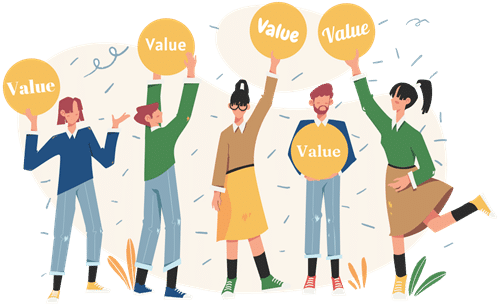Your workplace ‘culture’ is, broadly speaking, everything that feels normal on any given day.
People who spend any time working together will develop shared behaviours and methods over time. Commonplace conduct will emerge and soon most individuals might be adhering to some ‘rules’ without even realising it.
This is like a collective, unspoken personality, shaping how employees interact with each other, with customers and stakeholders, and profoundly affecting performance.

Organisational leaders recognise the power of a shared culture to drive unity. They invest significant time and resources into maintaining the quality of their products and services and shaping a strong brand identity, so why wouldn’t they also strive for consistency in the behaviours of the people who bring those things to life?
Many organisations take this a step further by defining and then pursuing a specific culture. Whether fostering one of, for example, inclusivity, coaching, safety or continuous improvement, the goal is creating an environment that reflects wider values and priorities. No single approach fits all, however, and there are no off-the-shelf, ready-made cultures to ‘airlift’ in – each organisation is shaped by its people, products, and many other unique factors.

One of the reasons for a targeted approach is that, in the absence of focused efforts, cultures have a habit of developing on their own. “Great news!”, you might think, “our market-leading products and our competent, experienced staff will form their own positive culture, normalise some effective and respectful behaviours, and minimal intervention is required!”
Unfortunately… cultures that are left to develop organically are more likely to be ineffective or even, in the worst scenarios, toxic. Without a clear overall ‘compass’, individuals may default to negative behaviours like presenteeism, discrimination or competitiveness – ones that align with their personal interests, rather than those of the company. Teams or colleagues that work closely together will begin to turn inwards and exclude others (also known as silo-ing).

One hallmark of any well-defined culture is large amounts of clear communication – without it, conjecture and assumption will fill the gaps and lead to confusion and mistrust. Without the accountability that a defined culture empowers, negative behaviours are more likely to go unchecked and become an embedded culture of their own – one that can be very challenging to unpick.
If you are successful in embedding and maintaining a shared culture, don’t worry – you won’t have turned your workforce into robots who talk and behave in exactly the same way. The goal isn’t to stifle individualism and personality, instead it’s to make sure that the unique contributions of your individual workers are aligned to one another, and to the overall ‘mission’ of the company. In fact, there’s evidence that cultures built around collaboration and teamwork can have a positive effect on creative task performance and idea generation. The ‘coaching culture’ – an increasingly popular type – can unlock some surprising benefits, such as an increased appetite for learning & development and more positive reactions to organisational change.

So why, as the title suggests, is workplace learning so crucial to the success of your culture construction project? Because if you are going to embed ways of behaving, you need to define what they are and why they are desirable. Depending on how quickly you’re looking to make progress (and the nuances of your desired culture) you may be suggesting a set of behaviours or, especially if there are problems to solve, insisting on them. Either way, it’s ineffective to describe how to act, without justifying it or explaining it in practical terms.
The most effective professional learning interventions move learners from theory to practice, showing them the theoretical reasons why it is worth changing the way they work, before explaining how they can start to do so. Without doing both of these things, learning can struggle to create the required motivation in the learners or the desired impact in the workplace. This is a challenge we have explored before, explaining how we look to solve it in the design and delivery of our learning solutions.

The learning that will spread your culture won’t just be sessions organised by the HR/L&D team – in fact, formal training will probably be just the start. If you subscribe to the 70:20:10 learning paradigm, individuals obtain the overwhelming majority of their knowledge from doing their day-to-day work (70%) and interacting with their colleagues (20%), with just a small amount (10%) coming from training. So, the culture you would like to see borne out in the work your teams do is also being grown there as well.
Whilst the 10% of knowledge you can control via ‘formal’ learning interventions is vital in supporting the skills and abilities that will shape your culture, the learning that an individual will pick up from the people around them will probably be more powerful. This is also reflected in the structure of our learning interventions, where learners are encouraged to bring, discuss and work through real workplace and customer challenges.

In response, your team leaders and senior managers must monitor this ‘natural’ learning, making sure the influential voices (probably the most experienced ones) are ‘bought in’ to the culture and have the skills (e.g. communication, delegation, motivation) to teach effectively. It’s also important to know that there is a shared and consistent approach to things like mentorship and performance review within teams.
If your culture is built on a shared set of values, these values could be ‘crowdsourced’ – employees have an opportunity to shape and define them, rather than having them suddenly appearing and being ‘dictated’ from above.

So, if you’re trying to shape and promote a certain culture, could you provide access to more or better learning that the people within it need? Do you have a handle on the ways in which your employees are learning informally within their day-to-day work? These elements will have a big impact on your ability to successfully shape the unspoken, collective personality of your workplace.
Rather than simply describing how everyone should behave, take the time and make the plans to ensure you are showing them why they should behave in a certain way, how they will go about doing so, and when you will know they have been successful.
As a training provider with decades of experience designing and delivering impactful learning and development projects, we would love to hear from you about your challenges. If there is a particular workplace culture you’re looking to embed, or you’ve identified some gaps in the skills and knowledge of your teams vs. their challenges and priorities, get in touch with our friendly team…